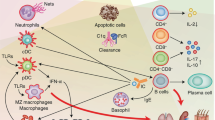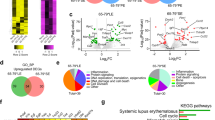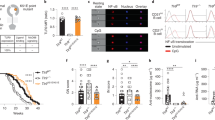Abstract
Although the etiology of systemic lupus erythematosus (SLE) remains to be fully elucidated, it is now apparent that multiple genetic and environmental factors are at play. Over the past decade, several studies have helped uncover genetic associations and susceptibility loci in human and murine lupus. In particular, recent genome-wide association studies have uncovered a large number of associated genes in human SLE. Given this plethora of candidate genes, the next challenge for lupus biologists is to fathom how these different genes operate to engender lupus. In this context, recent genetic studies in mouse models of lupus have been particularly informative. The purpose of this review is to overview three key genetically determined checkpoints in lupus development that have emerged from studies of NZM2410-derived congenic strains bearing individual lupus susceptibility loci. These three events include a breach in central tolerance in the adaptive arm of the immune system, peripheral amplification of the autoimmune response by the innate immune system and local processes in the target organ that facilitate end-organ disease. Collectively, murine congenic dissection studies provide a framework for understanding and analyzing the steady stream of gene candidates that are currently emerging from human lupus studies.
This is a preview of subscription content, access via your institution
Access options
Subscribe to this journal
Receive 6 digital issues and online access to articles
$119.00 per year
only $19.83 per issue
Buy this article
- Purchase on Springer Link
- Instant access to full article PDF
Prices may be subject to local taxes which are calculated during checkout

Similar content being viewed by others
References
Wakeland EK, Wandstrat AE, Liu K, Morel L . Genetic dissection of systemic lupus erythematosus. Curr Opin Immunol 1999; 11: 701–707.
Namjou B, Kilpatrick J, Harley JB . Genetics of clinical expression in SLE. Autoimmunity 2007; 40: 602–612.
Nath SK, Kilpatrick J, Harley JB . Genetics of human systemic lupus erythematosus: the emerging picture. Curr Opin Immunol 2004; 16: 794–800.
Wakeland EK, Liu K, Graham RR, Behrens TW . Delineating the genetic basis of systemic lupus erythematosus. Immunity 2001; 15: 397–408.
Rudofsky UH, Evans BD, Balaban SL, Mottironi VD, Gabrielsen AE . Differences in expression of lupus nephritis in New Zealand mixed H-2z homozygous inbred strains of mice derived from New Zealand black and New Zealand white mice. Origins and initial characterization. Lab Invest 1993; 68: 419–426.
Morel L, Rudofsky UH, Longmate JA, Schiffenbauer J, Wakeland EK . Polygenic control of susceptibility to murine systemic lupus erythematosus. Immunity 1994; 1: 219–229.
Morel L, Yu Y, Blenman KR, Caldwell RA, Wakeland EK . Production of congenic mouse strains carrying genomic intervals containing SLE-susceptibility genes derived from the SLE-prone NZM2410 strain. Mamm Genome 1996; 7: 335–339.
Morel L, Mohan C, Yu Y, Croker BP, Tian N, Deng A et al. Functional dissection of systemic lupus erythematosus using congenic mouse strains. J Immunol 1997; 158: 6019–6028.
Mohan C, Alas E, Morel L, Yang P, Wakeland EK . Genetic dissection of SLE pathogenesis. Sle1 on murine chromosome 1 leads to a selective loss of tolerance to H2A/H2B/DNA subnucleosomes. J Clin Invest 1998; 101: 1362–1372.
Sobel ES, Mohan C, Morel L, Schiffenbauer J, Wakeland EK . Genetic dissection of SLE pathogenesis: adoptive transfer of Sle1 mediates the loss of tolerance by bone marrow-derived B cells. J Immunol 1999; 162: 2415–2421.
Mohan C, Morel L, Yang P, Wakeland EK . Genetic dissection of systemic lupus erythematosus pathogenesis: Sle2 on murine chromosome 4 leads to B cell hyperactivity. J Immunol 1997; 159: 454–465.
Mohan C, Morel L, Yang P, Wakeland EK . Accumulation of splenic B1a cells with potent antigen-presenting capability in NZM2410 lupus-prone mice. Arthritis Rheum 1998; 41: 1652–1662.
Xu Z, Duan B, Croker BP, Wakeland EK, Morel L . Genetic dissection of the murine lupus susceptibility locus Sle2: contributions to increased peritoneal B-1a cells and lupus nephritis map to different loci. J Immunol 2004; 173: 6050–6058.
Mohan C, Yu Y, Morel L, Yang P, Wakeland EK . Genetic dissection of SLE pathogenesis: Sle3 on murine chromosome 7 impacts T cell activation, differentiation, and cell death. J Immunol 1999; 162: 6492–6502.
Sobel ES, Morel L, Baert R, Mohan C, Schiffenbauer J, Wakeland EK . Genetic dissection of systemic lupus erythematosus pathogenesis: evidence for functional expression of Sle3/5 by non-T cells. J Immunol 2002; 169: 4025–4032.
Mohan C, Morel L, Yang P, Watanabe H, Croker B, Gilkeson G et al. Genetic dissection of lupus pathogenesis: a recipe for nephrophilic autoantibodies. J Clin Invest 1999; 103: 1685–1695.
Morel L, Croker BP, Blenman KR, Mohan C, Huang G, Gilkeson G et al. Genetic reconstitution of systemic lupus erythematosus immunopathology with polycongenic murine strains. Proc Natl Acad Sci USA 2000; 97: 6670–6675.
Shi X, Xie C, Kreska D, Richardson JA, Mohan C . Genetic dissection of SLE: SLE1 and FAS impact alternate pathways leading to lymphoproliferative autoimmunity. J Exp Med 2002; 196: 281–292.
Subramanian S, Tus K, Li QZ, Wang A, Tian XH, Zhou J et al. A Tlr7 translocation accelerates systemic autoimmunity in murine lupus. Proc Natl Acad Sci USA 2006; 103: 9970–9975.
Shi X, Xie C, Chang S, Zhou XJ, Tedder T, Mohan C . CD19 hyper-expression augments Sle1-induced humoral autoimmunity but not clinical nephritis. Arthritis Rheum 2007; 56: 3057–3069.
Kono DH, Theofilopoulos AN . Genetics of systemic autoimmunity in mouse models of lupus. Int Rev Immunol 2000; 19: 367–387.
Morel L, Blenman KR, Croker BP, Wakeland EK . The major murine systemic lupus erythematosus susceptibility locus, Sle1, is a cluster of functionally related genes. Proc Natl Acad Sci USA 2001; 98: 1787–1792.
Wandstrat AE, Nguyen C, Limaye N, Chan AY, Subramanian S, Tian XH et al. Association of extensive polymorphisms in the SLAM/CD2 gene cluster with murine lupus. Immunity 2004; 21: 769–780.
Kumar KR, Li L, Yan M, Bhaskarabhatla M, Mobley AB, Nguyen C et al. Regulation of B cell tolerance by the lupus susceptibility gene Ly108. Science 2006; 312: 1665–1669.
Chen Y, Perry D, Boackle SA, Sobel ES, Molina H, Croker BP et al. Several genes contribute to the production of autoreactive B and T cells in the murine lupus susceptibility locus Sle1c. J Immunol 2005; 175: 1080–1089.
Boackle SA, Holers VM, Chen X, Szakonyi G, Karp DR, Wakeland EK et al. Cr2, a candidate gene in the murine Sle1c lupus susceptibility locus, encodes a dysfunctional protein. Immunity 2001; 15: 775–785.
Wu X, Jiang N, Deppong C, Singh J, Dolecki G, Mao D et al. A role for the Cr2 gene in modifying autoantibody production in systemic lupus erythematosus. J Immunol 2002; 169: 1587–1592.
Giles BM, Tchepeleva SN, Kachinski JJ, Ruff K, Croker BP, Morel L et al. Augmentation of NZB autoimmune phenotypes by the Sle1c murine lupus susceptibility interval. J Immunol 2007; 178: 4667–4675.
Banchereau J, Steinman RM . Dendritic cells and the control of immunity. Nature 1998; 392: 245–252.
Stetson DB, Medzhitov R . Type I interferons in host defense. Immunity 2006; 25: 373–381.
Meylan E, Tschopp J, Karin M . Intracellular pattern recognition receptors in the host response. Nature 2006; 442: 39–44.
Vyse TJ, Kotzin BL . Genetic susceptibility to systemic lupus erythematosus. Annu Rev Immunol 1998; 16: 261–292.
Kong PL, Morel L, Croker BP, Craft J . The centromeric region of chromosome 7 from MRL mice (Lmb3) is an epistatic modifier of Fas for autoimmune disease expression. J Immunol 2004; 172: 2785–2794.
Wakui M, Kim J, Butfiloski EJ, Morel L, Sobel ES . Genetic dissection of lupus pathogenesis: Sle3/5 impacts IgH CDR3 sequences, somatic mutations, and receptor editing. J Immunol 2004; 173: 7368–7376.
Zhu J, Liu X, Xie C, Yan M, Yu Y, Sobel ES et al. T cell hyperactivity in lupus as a consequence of hyperstimulatory antigen-presenting cells. J Clin Invest 2005; 115: 1869–1878.
Ding D, Mehta H, McCune WJ, Kaplan MJ . Aberrant phenotype and function of myeloid dendritic cells in systemic lupus erythematosus. J Immunol 2006; 177: 5878–5889.
Blanco P, Palucka AK, Gill M, Pascual V, Banchereau J . Induction of dendritic cell differentiation by IFN-alpha in systemic lupus erythematosus. Science 2001; 294: 1540–1543.
Murphy ED, Roths JB . A Y chromosome associated factor in strain BXSB producing accelerated autoimmunity and lymphoproliferation. Arthritis Rheum 1979; 22: 1188–1194.
Izui S . Autoimmune accelerating genes, lpr and Yaa, in murine systemic lupus erythematosus. Autoimmunity 1990; 6: 113–129.
Steinberg RT, Miller ML, Steinberg AD . Effect of the BXSB Y chromosome accelerating gene on autoantibody production. Clin Immunol Immunopathol 1985; 35: 67–72.
Hudgins CC, Steinberg RT, Klinman DM, Reeves MJ, Steinberg AD . Studies of consomic mice bearing the Y chromosome of the BXSB mouse. J Immunol 1985; 134: 3849–3854.
Izui S, Higaki M, Morrow D, Merino R . The Y chromosome from autoimmune BXSB/MpJ mice induces a lupus-like syndrome in (NZW × C57BL/6) F1 male mice, but not in C57BL/6 male mice. Eur J Immunol 1988; 18: 911–915.
Pisitkun P, Deane JA, Difilippantonio MJ, Tarasenko T, Satterthwaite AB, Bolland S . Autoreactive B cell responses to RNA-related antigens due to TLR7 gene duplication. Science 2006; 312: 1669–1672.
Rozzo S, Allard J, Choubey D, Vyse T, Izui S, Peltz G et al. Evidence for an interferon-inducible gene, Ifi202, in the susceptibility to systemic lupus. Immunity 2002; 15: 435–443.
Xin H, D’Souza S, Jorgensen TN, Vaughan AT, Lengyel P, Kotzin BL et al. Increased expression of Ifi202, an IFN-activatable gene, in B6.Nba2 lupus susceptible mice inhibits p53-mediated apoptosis. J Immunol 2006; 176: 5863–5870.
Panchanathan R, Xin H, Choubey D . Disruption of mutually negative regulatory feedback loop between interferon-inducible p202 protein and the E2F family of transcription factors in lupus-prone mice. J Immunol 2008; 180: 5927–5934.
Yu D, Tan AH, Hu X, Athanasopoulos V, Simpson N, Silva DG et al. Roquin represses autoimmunity by limiting inducible T-cell co-stimulator messenger RNA. Nature 2007; 450: 299–303.
Gubbels MR, Jørgensen TN, Metzger TE, Menze K, Steele H, Flannery SA et al. Effects of MHC and gender on lupus-like autoimmunity in Nba2 congenic mice. Immunol 2005; 175: 6190–6196.
Morel L, Tian XH, Croker BP, Wakeland EK . Epistatic modifiers of autoimmunity in a murine model of lupus nephritis. Immunity 1999; 11: 131–139.
Hahn BH . Antibodies to DNA. N Engl J Med 1998; 338: 1359.
Lefkowith JB, Gilkeson GS . Nephritogenic autoantibodies in lupus. Current concepts and continuing controversies. Arthritis Rheum 1996; 39: 894.
Tang T, Rosenkranz A, Assmann KM, Goodman MJ, Gutierrez-Ramos JC, Carroll MC et al. A role for Mac-1 (CDllb/CD18) in immune complex-stimulated neutrophil function in vivo: Mac-1 deficiency abrogates sustained Fcgamma receptor-dependent neutrophil adhesion and complement-dependent proteinuria in acute glomerulonephritis. J Exp Med 1997; 186: 1853.
Hebert MJ, Takano T, Papayianni A, Rennke HG, Minto A, Salant DJ et al. Acute nephrotoxic serum nephritis in complement knockout mice: relative roles of the classical and alternate pathways in neutrophil recruitment and proteinuria. Nephrol Dial Transplant 1998; 13: 2799.
Suzuki Y, Shirato I, Okumura K, Ravetch JV, Takai T, Tomino Y et al. Distinct contribution of Fc receptors and angiotensin II-dependent pathways in anti-GBM glomerulonephritis. Kidney Int 1998; 54: 1166.
Clynes R, Dumitru C, Ravetch JV . Uncoupling of immune complex formation and kidney damage in autoimmune glomerulonephritis. Science 1998; 279: 1052.
Le Hir M, Haas C, Marino M, Ryffel B . Prevention of crescentic glomerulonephritis induced by anti-glomerular membrane antibody in tumor necrosis factor-deficient mice. Lab Invest 1998; 78: 1625.
Janssen U, Ostendorf T, Gaertner S, Eitner F, Hedrich HJ, Assmann KJ et al. Improved survival and amelioration of nephrotoxic nephritis in intercellular adhesion molecule-1 knockout mice. J Am Soc Nephrol 1998; 9: 1805.
Quintero-Del-Rio AI, Kelly JA, Kilpatrick J, James JA, Harley JB . The genetics of systemic lupus erythematosus stratified by renal disease: linkage at 10q22.3 (SLEN1), 2q34–35 (SLEN2), and 11p15.6 (SLEN3). Genes Immun 2002; 3 (Suppl 1): S57–S62.
Bakkaloglu A, Soylemezoglu O, Tinaztepe K, Saatci U, Soylemezoglu F . Familial membranoproliferative glomerulonephritis. Nephrol Dial Transplant 1995; 10: 21–24.
Nowack R, Lehmann H, Flores-Suarez LF, Nanhou A, van der Woude FJ . Familial occurrence of systemic vasculitis and rapidly progressive glomerulonephritis. Am J Kidney Dis 1999; 34: 364–373.
Kaplan JM, Kim SH, North KN, Rennke H, Correia LA, Tong HO et al. Mutations in ACTN4, encoding alpha-actinin-4, cause familial focal segmental glomerulosclerosis. Nat Genet 2000; 24: 251–256.
Freedman BI, Spray BJ, Tuttle AB, Buckalew Jr VM . The familial risk of end-stage renal disease in African Americans. Am J Kidney Dis 1993; 21: 387–393.
Freedman BI, Tuttle AB, Spray BJ . Familia/predisposition to nephropathy in African-Americans with non-insulin-dependent diabetes mellitus. Am J Kidney Dis 1995; 25: 710–713.
Freedman BI, Wilson CH, Spray BJ, Tuttle AB, Olorenshaw IM, Kammer GM . Familial clustering of end-stage renal disease in blacks with lupus nephritis. Am J Kidney Dis 1997; 29: 729–732.
Bergman S, Key BO, Kirk KA, Warnock DG, Rostant SG . Kidney disease in the first-degree relatives of African-Americans with hypertensive end-stage renal disease. Am J Kidney Dis 1996; 27: 341–346.
Masugi M . Glomerulonephritis durch das spezifische antinierenserum: ein Beitrag zur Pathogenese der diffusen Glomerulonephritis. Beitr Pathol Anat Allg Pathol 1934; 92: 429.
Fu Y, Yong D, Mohan C . The experimental anti-GBM model as a tool for studying spontaneous lupus nephritis. Clin Immunol 2007; 124: 109–118.
Liu K, Li QZ, Delgado-Vega AM, Abelson AK, Sanchez E, Kelly JA et al. Kallikreins as disease genes in anti-GBM disease and lupus nephritis. J Clin Invest 2008 (in press).
Rhodes B, Vyse TJ . The genetics of SLE: an update in the light of genome-wide association studies. Rheumatology 2008; 47: 1603–1611.
Yokoyama K, Su I, Tezuka T, Yasuda T, Mikoshiba K, Tarakhovsky A et al. BANK regulates BCR-induced calcium mobilization by promoting tyrosine phosphorylation of IP3 receptor. EMBO J 2002; 21: 83–92.
Dymecki SM, Zwollo P, Zeller K, Kuhajda FP, Desiderio SV . Structure and developmental regulation of the B-lymphoid tyrosine kinase gene blk. J Biol Chem 1992; 267: 4815–4823.
Wasserman R, Li YS, Hardy RR . Differential expression of the blk and ret tyrosine kinases during B lineage development is dependent on Ig rearrangement. J Immunol 1995; 155: 644–651.
Carroll MC . The role of complement in B cell activation and tolerance. Adv Immunol 2000; 74: 61–88.
Sohn JH, Bora PS, Suk HJ, Molina H, Kaplan HJ, Bora NS . Tolerance is dependent on complement C3 fragment iC3b binding to antigen-presenting cells. Nat Med 2003; 9: 206–212.
Wardemann H, Yurasov S, Schaefer A, Young JW, Meffre E, Nussenzweig MC . Predominant autoantibody production by early human B cell precursors. Science 2003; 301: 1374–1377.
Yurasov S, Wardemann H, Hammersen J, Tsuiji M, Meffre E, Pascual V et al. Defective B cell tolerance checkpoints in systemic lupus erythematosus. J Exp Med 2005; 201: 703–711.
Boone DL, Turer EE, Lee EG, Ahmad R-C, Wheeler MT, Tsui C et al. The ubiquitin-modifying enzyme A20 is required for termination of Toll-like receptor responses. Nat Immunol 2004; 5: 1052–1060.
Schoenemeyer A, Barnes BJ, Mancl ME, Latz E, Goutagny N, Pitha PM et al. The interferon regulatory factor, IRF5, is a central mediator of Toll-like receptor 7 signaling. J Biol Chem 2005; 280: 17005–17012.
Stuber E, Strober W . The T cell-B cell interaction via OX40-OX40L is necessary for the T cell-dependent humoral immune response. J Exp Med 1996; 183: 979–989.
Gregersen PK, Lee H-S, Batliwalla F, Begovich AB . PTPN22: setting thresholds for autoimmunity. Semin Immunol 2006; 18: 214–223.
Nishimura H, Honjo T . PD-1: an inhibitory immunoreceptor involved in peripheral tolerance. Trends Immunol 2001; 22: 265–268.
Stetson DB, Joan S, Ko JS, Heidmann T, Medzhitov R . Trex1 prevents cell-intrinsic initiation of autoimmunity. Cancer Cell 2008; 134: 587–598.
Jacob CO, Zang S, Li L, Ciobanu V, Quismorio F, Mizutani A et al. Pivotal role of Stat4 and Stat6 in the pathogenesis of the Lupus-like disease in the New Zealand mixed 2328 mice. J Immunol 2003; 171: 1564–1571.
Quigg RJ, Kozono Y, Berthiaume D, Lim A, Salant DJ, Weinfeld A et al. Blockade of antibody-induced glomerulonephritis with Crry-Ig, a soluble murine complement inhibitor. J Immunol 1998; 160: 4553–4560.
Cochrane CG, Unanue ER, Dixon FJ . A role of polymorphonuclear leukocytes and complement in nephrotoxic nephritis. J Exp Med 1965; 122: 99–116.
Dunne JL, Collins RG, Beaudet AL, Ballantyne CM, Ley K . Mac-1, but not LFA-1, uses intercellular adhesion molecule-1 to mediate slow leukocyte rolling in TNF-alpha-induced inflammation. J Immunol 2003; 171: 6105–6111.
Author information
Authors and Affiliations
Corresponding author
Rights and permissions
About this article
Cite this article
Kanta, H., Mohan, C. Three checkpoints in lupus development: central tolerance in adaptive immunity, peripheral amplification by innate immunity and end-organ inflammation. Genes Immun 10, 390–396 (2009). https://doi.org/10.1038/gene.2009.6
Received:
Accepted:
Published:
Issue Date:
DOI: https://doi.org/10.1038/gene.2009.6
Keywords
This article is cited by
-
The association of CD40 polymorphism (rs1883832C/T) and soluble CD40 with the risk of systemic lupus erythematosus among Egyptian patients
Clinical Rheumatology (2019)
-
The assessment of serum-mediated phagocytosis of necrotic material by polymorphonuclear leukocytes to diagnose and predict the clinical features of systemic lupus erythematosus: an observational longitudinal study
Arthritis Research & Therapy (2016)
-
Immunopathology of lupus nephritis
Seminars in Immunopathology (2014)
-
Treatment targets in systemic lupus erythematosus: biology and clinical perspective
Arthritis Research & Therapy (2012)
-
A novel pathogenetic concept—antiviral immunity in lupus nephritis
Nature Reviews Nephrology (2012)



